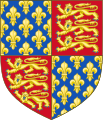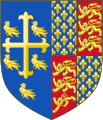利用者:Omaemona1982/下書き2
表示

イングランド王室紋章(イングランドおうしつもんしょう)は、かつてのイングランド王の紋章である。
プランタジネット朝の創始者ヘンリー2世がライオンの紋章を採用し、リチャード1世が1頭だったライオンを3頭に増やしたと言われている。サッカーイングランド代表のマークはこれを元に、イングランドの国花のバラをあしらったもので、UMBRO社のデザインである。
その後、エドワード3世が百年戦争で1340年1月26日にフランス王を称した際に王室紋章のシールドを四分して第1と第3クォーターにフランス王室紋章のユリの花(フルール・ド・リス)、第2と第4クォーターを従来のイングランドの3匹の歩くライオンの物にした[1]。
1801年1月にアイルランドを併合してグレートブリテンおよびアイルランド連合王国が成立すると、イギリス王ジョージ3世はフランス王の称号の使用を中止した。英国首相小ピットはイギリスが対仏戦争でフランスの併合を狙っているわけではないことを示すため国王にフランス王の称号を名乗らせるのをやめたのだった[2]。これに伴ってイギリス王室の紋章からフランス王室を示すフルール・ド・リスの紋章は取り除かれた。
| イングランド王国 (1603年から1707年までスコットランド王国と同君連合) | |
|---|---|
| 紋章 | 期間 |
 |
1189年–1198年(リチャード1世) |
 |
1198年-1340年(リチャード2世、ジョン、ヘンリー3世、エドワード1世、エドワード2世、エドワード3世) 1360年-1369年(エドワード3世) |
 |
フランス王位請求でフランス王室紋章のユリの花(フルール・ド・リス)の追加 1340年-1360年(エドワード3世) 1369年-1395年(エドワード3世・リチャード2世) 1399年-1406年(ヘンリー4世) |
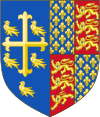 |
エドワード懺悔王の象徴紋章追加 1395年-1399年(リチャード2世) |
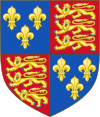 |
フランス王シャルル5世の紋章にあわせてユリの花の数を3つにする 1406年–1422年(ヘンリー4世、ヘンリー5世) 1461年–1470年(エドワード4世) 1471年–1554年(エドワード4世、エドワード5世、リチャード3世、ヘンリー7世、ヘンリー8世、エドワード6世) 1558年–1603年(エリザベス1世) |
 |
イングランド・フランス二重王国を強調するため更にフランス王室の紋章追加 1422年–1461年(ヘンリー6世) 1470年–1471年(ヘンリー6世) |
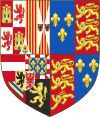 |
スペイン王フェリペ2世との結婚でスペイン王室の紋章追加 1554年–1558年(メアリー1世) |
-
1395年-1399年(リチャード3世)
| Kingdom of England (Under personal union with the Kingdom of Scotland from 1603–1707) | ||||
|---|---|---|---|---|
| Escutcheon | Period | Description | ||
 |
1189–1198 | The arms of Richard I are only known from two armorial seals, and hence the tinctures can not be determined. His First Great Seal showed one lion on half of the shield. It is debated whether this was meant to represent two lions combatant or a single lion, and if the latter, whether the direction in which the lion is facing is relevant or simply an artistic liberty. A simple lion rampant is most likely.[3] | ||
 |
1198–1340 1360–1369 |
The arms on the second Great Seal of Richard I, used by his successors until 1340: Gules, three lions passant guardant in pale or (Three golden lions on a red field, representing the ruler of the Kingdom of England, Duchy of Normandy and the Duchy of Aquitaine).[4][5] | ||
 |
1340–1360 1369–1395 1399–1406 |
Edward III adopted the Royal Arms of France Azure semé of fleurs de lys or (powdering of fleurs-de-lis on a blue field) – representing his claim to the French throne - and quartered the Royal Arms of England. | ||
 |
1395–1399 | Richard II adopted the attributed arms of King Edward the Confessor which he impaled with the Royal Arms of England, denoting a mystical union. | ||
 |
1406–1422 | Henry IV abandoned the attributed arms of King Edward the Confessor, and reduced the fleurs-de-lis to three, in imitation of Charles V of France.[5][6] | ||
 |
1422–1461 1470–1471 |
Henry VI adopted the arms of France and impaled the arms of England, symbolising the dual monarchy, with France shown in the dexter position of greatest honour. | ||
 |
1461–1470 1471–1554 |
Edward IV restored the arms of Henry IV.[6] | ||
 |
1554–1558 | Mary I and Philip impaled their arms. Philip's arms were: A. Arms quarterly Castile and Leon, B. per pale Aragon and Aragon-Sicily, the whole enté en point Granada; in base quarterly Austria, Burgundy ancient, Burgundy modern and Brabant, with an escutcheon (in the nombril point) per pale Flanders and Tyrol.[5][6] Although Queen Mary I's father, King Henry VIII, assumed the title of King of Ireland and this was further conferred upon King Philip, the arms were not altered to feature the Kingdom of Ireland.
| ||
 |
1558–1603 | Elizabeth I restored the arms of Henry IV.[5] | ||
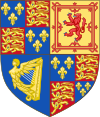 |
1603–1649 1660–1689 |
James I inherited the English throne in 1603, establishing a union with Scotland, and quartered the Royal Arms of England with those of Scotland. The Royal Arms of Ireland was added to represent the Kingdom of Ireland. Last used by Anne, this was the final version of the Royal Arms of England before being subsumed into the Royal Arms of Great Britain.[5][6] | ||
 |
1689–1694 | James II was deposed and replaced with his daughter Mary II and son-in-law and nephew William III. As co-monarchs, they impaled their arms: William bore the Royal Arms with the addition of an escutcheon of Nassau (the royal house to which William belonged): Azure billetty or, a lion rampant of the last armed and langued gules, while Mary bore the Royal Arms undifferenced.[8] | ||
 |
1694–1702 | After the death of Mary II, William III reigned alone, and used his arms only.[5] | ||
 |
1702–1707 | Anne inherited the throne upon the death of William III, and the Royal Arms returned to the 1603 version.[5] | ||
脚注
[編集]- ^ 森護 1986, p. 144.
- ^ 近藤和彦(編) 2002, p. 32-33-34.
- ^ Ailes. pp. 52–3, 64–74.
- ^ 引用エラー: 無効な
<ref>タグです。「Blazon01」という名前の注釈に対するテキストが指定されていません - ^ a b c d e f g 引用エラー: 無効な
<ref>タグです。「Boutell」という名前の注釈に対するテキストが指定されていません - ^ a b c d 引用エラー: 無効な
<ref>タグです。「knight」という名前の注釈に対するテキストが指定されていません - ^ Francisco Olmos, José María de. «Las primeras acuñaciones del príncipe Felipe de España (1554–1556): Soberano de Milán Nápoles e Inglaterra». «The First Coins of Prince Philip of Spain (1554–1556): Sovereign of Milan, Naples and England», pp. 165–166. Documenta & Instrumenta, 3 (2005). Madrid, Universidad Complutense. PP. 155–186.
- ^ Arnaud Bunel's Héraldique européenne site[リンク切れ]
参考文献
[編集]- 近藤和彦(編)『長い18世紀のイギリス その政治社会』山川出版社、2002年(平成14年)。ISBN 978-4634647107。
- 森護『英国王室史話』大修館書店、1986年(昭和61年)。ISBN 978-4469240900。


